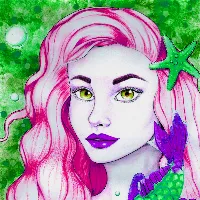This quilt was entirely handmade by my grandmother. The style is an old classic known as the patchwork quilt, so called because the top is made of "patches" — squares of cloth that are often taken from remnants left-over from other sewing projects or from old clothing that has worn-out and been cast aside. These squares are carefully stitched together to form the "quilt top."
The quilt top is usually the only surface that has a design on it, while the lining (or backing) on the reverse side is commonly plain.
For some patchwork quilts, the squares on the quilt top are arranged to form large, elaborate patterns of some sort, but simpler, utilitarian quilts such as this were intended to be used rather than displayed, and contain a fascinating mish-mash of squares. Sometimes the individual squares are arranged together to form a "block" and sometimes the squares are larger and stand as a "block" on their own.
A plain piece of fabric (called the "lining" or "backing") is placed beneath the other two layers and then all layers are stitched together in a very detailed process across the entire surface of the quilt. Stitches are made all the way through the three layers to hold them together, and these stitches go around each square and block — this technique is the process called "quilting," from which the item takes its name.
The quilting step is often facilitated by the use of a special wooden frame, called a "quilting frame," that keeps the fabric taut and prevents the layers of fabric from shifting while being stitched. As this is the most time-consuming part of making a quilt, women would often gather together to conduct "quilting bees" where everyone would pitch-in so that the job could be completed faster. This was sometimes done on a routine basis, but especially when a young woman in the community was preparing for marriage or the birth of a baby. She would then return the favor by helping in other quilting bees.
Once the quilting process is complete, the last step is to stitch around the edges of the quilt. The edges of this quilt's top and lining were folded inside, towards the batting, and stitched very carefully and expertly. I am so proud of the beautiful job my grandmother did with this lovely quilt and I treasure it! 💖
My favorite square as a child was the one shown in the photo below. I liked the juxtaposition of colors — pink, green, and purple — and the exotic-looking building pictured, like something from the deserts of Morocco. There was also something about it that looked like a sewing-machine to my five-year-old mind, perhaps because of the tall, needle-like towers/minarets, and especially when the building is upside-down... 😂 When the quilt was found, it was actually that "sewing machine" design that confirmed it was the quilt that my grandmother made, rocketing me back to my childhood in the house that my father built so many years ago.
https://steemitimages.com/0x0/https://cdn.steemitimages.com/DQmPM1JABtfbJDy4G5ZEGysVtoz9nNYGtJGPB6sGcHTVHtc/#thealliance%[email protected]

02-Apr-2019
Return from Mama's Quilt to 𝕜𝕚𝕥𝕥𝕪's Web3 Blog


